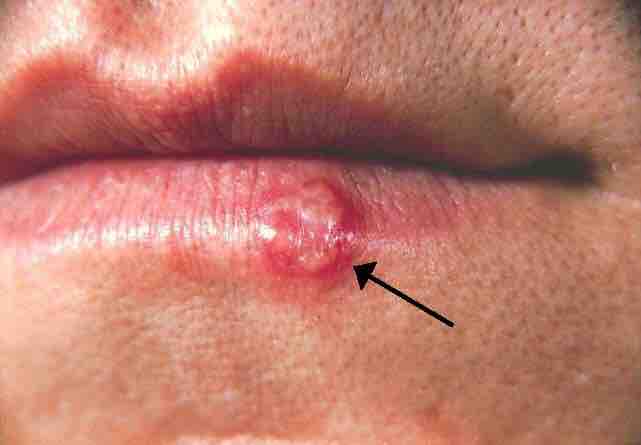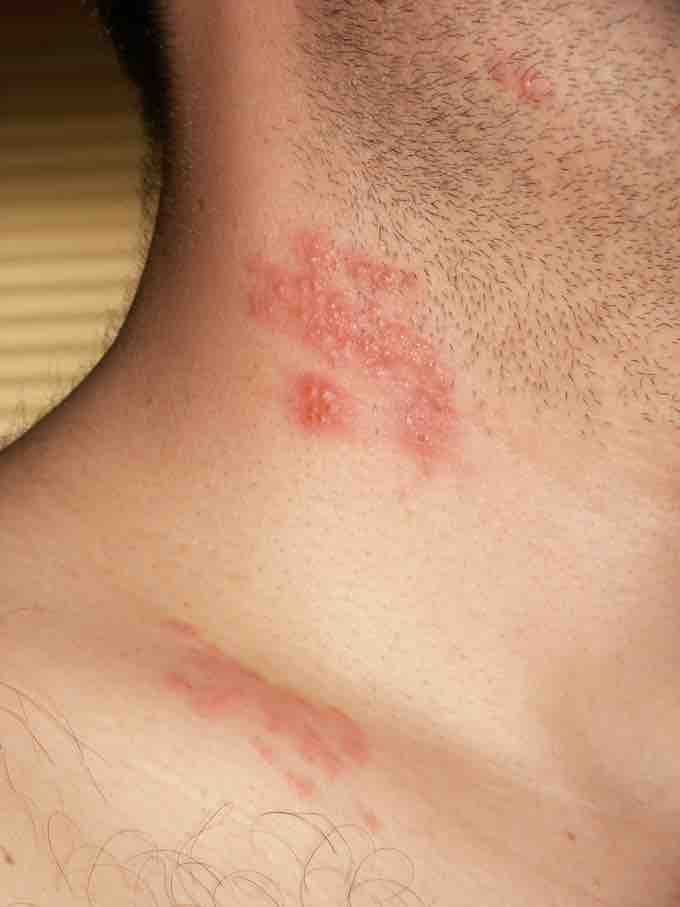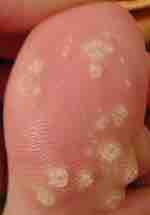Virus-related cutaneous conditions are caused by two main groups of viruses–DNA and RNA types–both of which are obligatory intracellular parasites.
A cutaneous condition is any medical condition that affects the integumentary system — the organ system that comprises the entire surface of the body and includes skin, hair, nails, and related muscle and glands. Conditions of the human integumentary system constitute a broad spectrum of diseases, also known as dermatoses. While only a small number of skin diseases account for most visits to the physician, thousands of skin conditions have been described. Three common skin conditions that result from viral infections are cold sores, shingles, and warts.
Herpes simplex is a viral disease from the herpesviridae family caused by both Herpes simplex virus type 1 (HSV-1) and type 2 (HSV-2). Infection with the herpes virus is categorized into one of several distinct disorders based on the site of infection. Oral herpes , the visible symptoms of which are colloquially called cold sores or fever blisters, is an infection of the face or mouth and is the most common form of infection. Genital herpes, known simply as herpes, is the second most common form of herpes. Herpes simplex is most easily transmitted by direct contact with a lesion or the body fluid of an infected individual. Transmission may also occur through skin-to-skin contact during periods of asymptomatic shedding. Barrier protection methods are the most reliable method of preventing transmission of herpes, but they merely reduce rather than eliminate risk. Oral herpes is easily diagnosed if the patient presents with visible sores or ulcers. Once infected, the virus remains in the body for life. Recurrent infections (outbreaks) may occur from time to time, especially in times of immune impairment such as HIV and cancer-related immune suppression. However, after several years, outbreaks become less severe and more sporadic, and some people will become perpetually asymptomatic and will no longer experience outbreaks, though they may still be contagious to others. Treatments with antivirals can reduce viral shedding and alleviate the severity of symptomatic episodes.

Herpes simplex
Herpes labialis or cold sore of the lower lip. Note the blisters in a group marked by an arrow.
Herpes zoster (or simply zoster), commonly known as shingles, is a viral disease characterized by a painful skin rash with blisters in a limited area on one side of the body, often in a stripe. The initial infection with varicella zoster virus (VZV) causes the acute (short-lived) illness chickenpox which generally occurs in children and young people. Once an episode of chickenpox has resolved, the virus is not eliminated from the body but remains latent and can go on to cause shingles—an illness with very different symptoms—often many years after the initial infection. Although the zoster rash usually heals within two to four weeks, some sufferers experience residual nerve pain for months or years, a condition called postherpetic neuralgia. Exactly how the virus remains latent in the body, and subsequently re-activates is not understood. The earliest symptoms of herpes zoster, which include headache, fever, and malaise, are nonspecific, and may result in an incorrect diagnosis. In most cases after 1–2 days, but sometimes as long as three weeks, the initial phase is followed by the appearance of the characteristic skin rash. The pain and rash most commonly occurs on the torso, but can appear on the face, eyes, or other parts of the body. At first the rash appears similar to the first appearance of hives. However, unlike hives, herpes zoster causes skin changes limited to a dermatome, normally resulting in a stripe or belt-like pattern that is limited to one side of the body and does not cross the midline. The goals of treatment are to limit the severity and duration of pain, shorten the duration of a shingles episode, and reduce complications. Symptomatic treatment is often needed for the complication of postherpetic neuralgia. Topical lotions containing calamine can be used on the rash or blisters and may be soothing. Antiviral drugs inhibit VZV replication and reduce the severity and duration of herpes zoster with minimal side effects, but do not reliably prevent postherpetic neuralgia. Of these drugs, acyclovir has been the standard treatment.

Herpes Zoster Neck
Herpes zoster blisters on the neck and shoulder.
A wart is generally a small, rough growth, typically on a human's hands or feet , but often other locations, that can resemble a cauliflower or a solid blister. They are caused by a viral infection, specifically by one of the many types of human papillomavirus (HPV). It is possible to get warts from others. They are contagious and usually enter the body in an area of broken skin. They typically disappear after a few months but can last for years and can recur. Gardasil is an HPV vaccine aimed at preventing cervical cancers and genital warts. There are many treatments and procedures associated with wart removal.

Warts
Warts on the big toe.